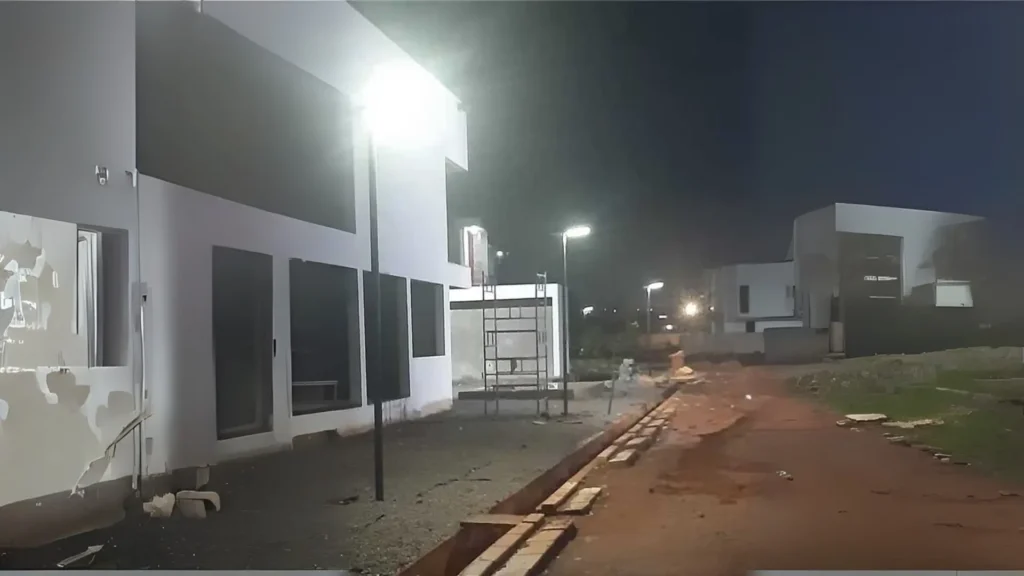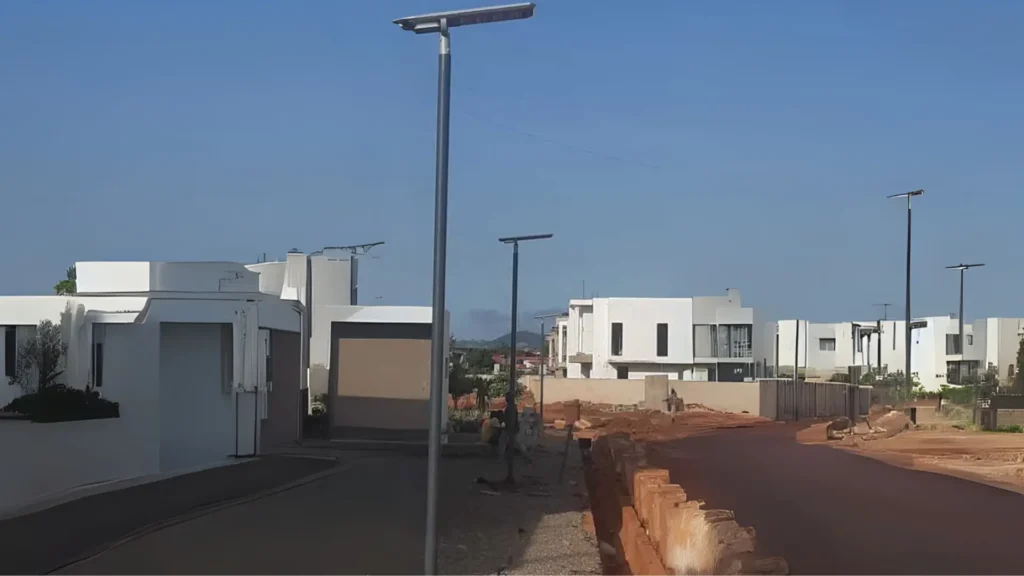1: Project Background and Needs Analysis
1.1 Project Overview: Lighting Needs in Ghana’s Urbanization Process
Project Location: A newly developed residential area in Ghana.
Project Background: As Ghana’s urbanization accelerates, the development of emerging residential areas has become a key component in improving living standards. However, these newly constructed communities often face infrastructure challenges, especially limited access to stable electricity. The construction site vividly represents the transformation of an empty plot into a modern neighborhood—where lighting, as a core infrastructure element, plays a vital role in ensuring smooth progress and enhancing future residents’ quality of life.
Core Objective: In the early phase of development, the goal was to deploy a reliable, independent, and cost-effective public lighting system. This would not only provide safety during construction but also establish a strong foundation for nighttime living once residents move in.
1.2 Core Challenges and Lighting Requirements
Lack of Power Infrastructure: Newly developed communities are often located far from existing municipal power grids. Connecting to the grid is both expensive and time-consuming. As a result, an off-grid lighting solution is urgently needed.
Dual Safety Needs for Construction and Residency:
-
Construction Phase: Construction materials and equipment are susceptible to theft, especially in poorly lit areas. Nighttime lighting reduces the risk of theft and provides safer conditions for nighttime operations and patrols.
-
Residency Phase: Once the community is inhabited, consistent and stable lighting becomes essential to ensure personal safety, deter crime, and enhance quality of life.
Adapting to Ghana’s Humid Tropical Climate: Ghana’s location in the tropics brings high humidity and distinct rainy seasons. Lighting equipment must operate reliably under high heat and remain functional during long rainy periods.
Cost-Effectiveness and Sustainability: Developers sought a long-term solution with minimal operational costs. By optimizing the initial investment, the project aimed to ensure long-term economic feasibility and environmental sustainability.
2: Technical Solution Design
2.1 Product Selection: Sresky ATLAS Series
After evaluating multiple solutions, the Sresky ATLAS Series solar street lights were selected. With advanced design and high adaptability to African environmental conditions, these lights emerged as the ideal choice for Ghana’s developing communities.
2.2 Key Technical Advantages and Project Compatibility
Core Technology 1: ALS Intelligent Light Decay Extension Technology
-
Function Overview: ALS intelligently adjusts light output and energy distribution, ensuring the lights remain functional even after over 10 consecutive days of rain.
-
Project Compatibility: Ghana’s extended rainy seasons often result in low sunlight. ALS eliminates the risk of blackout caused by insufficient charging, maintaining community safety 24/7.
Core Technology 2: TCS Intelligent Temperature Control System
-
Function Overview: TCS monitors and regulates battery temperature in real time, protecting it from damage in high temperatures. It operates efficiently across a wide range of -20°C to 60°C.
-
Project Compatibility: Ghana’s high ambient temperatures are well-managed by TCS, which prolongs battery life, reduces maintenance needs, and ensures long-term reliability.
Core Technology 3: PIR Intelligent Human Motion Sensor
-
Function Overview: The PIR sensor detects motion within 120° and up to 8 meters. It shifts from low brightness (or off) to full brightness when someone is detected.
-
Project Compatibility: For residential roads with low nighttime traffic, this sensor boosts energy efficiency by adjusting brightness only when needed—balancing energy conservation with intelligent operation.
Exceptional Performance Guarantee
-
High-Efficiency Power Generation and Lighting: The ATLAS Series uses monocrystalline silicon panels with over 23% conversion efficiency, paired with LED chips delivering up to 230 lm/W. This ensures an efficient cycle of “generate more, consume less.”
-
Durable and Robust: With IP65 waterproof and IK08 impact resistance ratings, the system withstands heavy rains and dust storms, ensuring stable operation in harsh environments.
3: Project Implementation and Deployment
3.1 Lighting First: Synchronizing with Construction
Deployment Strategy: Installation of Sresky ATLAS lights was executed alongside building construction. Daytime was for construction work, while nighttime lighting enhanced site safety. This “lighting first” strategy improved efficiency and supported long-term residential planning.
Installation Process: A standardized method was followed—foundation pouring, lamp post fixation, and light assembly—eliminating the need for complex grid installation and greatly shortening deployment time.
3.2 From Construction Site to Community Illumination
Daytime Scene: Lamp posts rise across the site, marking the beginning of infrastructure development and representing the promise of a brighter future.
Nighttime Scene: As darkness falls, the ATLAS streetlights highlight construction outlines and scattered materials. More than a practical light source, they symbolize hope and safety—enabling future residents to envision life in a well-lit and secure neighborhood.
4: Project Outcomes and Impact
4.1 Core Social Value
-
Establishing Community Safety: From the construction stage onward, lighting eliminated darkness-related hazards, creating a secure environment for both workers and future residents. This boost in safety significantly improves the community’s attractiveness to potential homeowners.
-
Enhancing Quality of Life: Stable lighting promotes nighttime activity—residents can walk, socialize, or relax outdoors—transforming the space into a livable, vibrant community.
4.2 Economic and Environmental Value
-
Zero Electricity Costs & Low Maintenance: By removing grid dependency, the project avoids monthly utility bills and reduces upkeep costs.
-
Raising Property Value: Communities with green, self-powered lighting systems stand out in the market, offering developers better returns.
-
Supporting Green Development: Powered 100% by clean solar energy, the project contributes to emissions reduction, aligns with global sustainability goals, and supports Ghana’s environmental initiatives.
Conclusion
The Ghana Emerging Residential Area Project, through the deployment of Sresky ATLAS solar street lights, has successfully tackled lighting challenges in underserved areas. It delivers comprehensive value in terms of safety, improved living standards, and sustainability. This advanced, off-grid lighting solution showcases how technology can empower community development. From barren construction zones to flourishing residential spaces, this “journey of light” sets a powerful benchmark for the future of African urban growth.
Table of Contents

